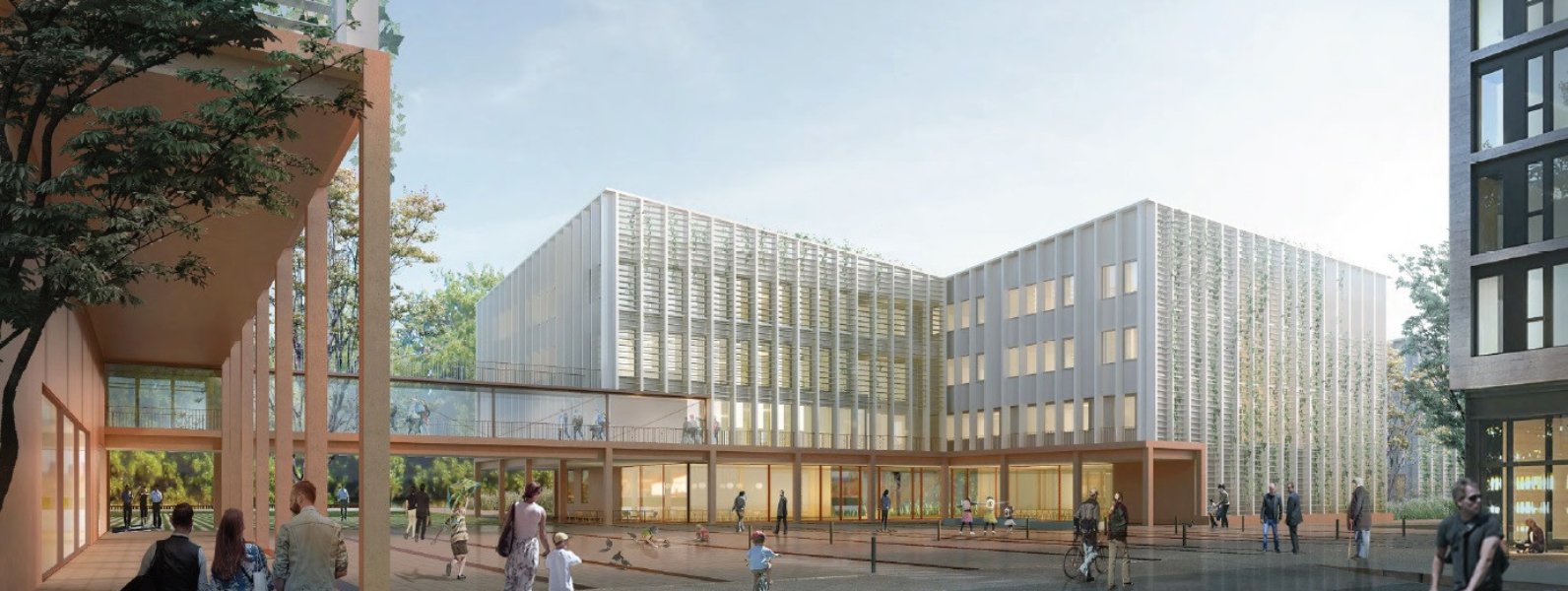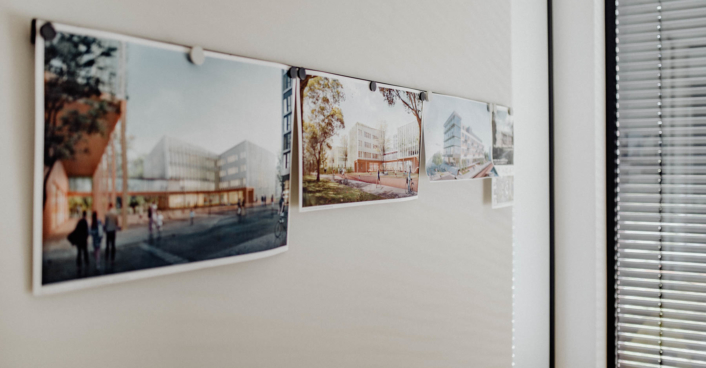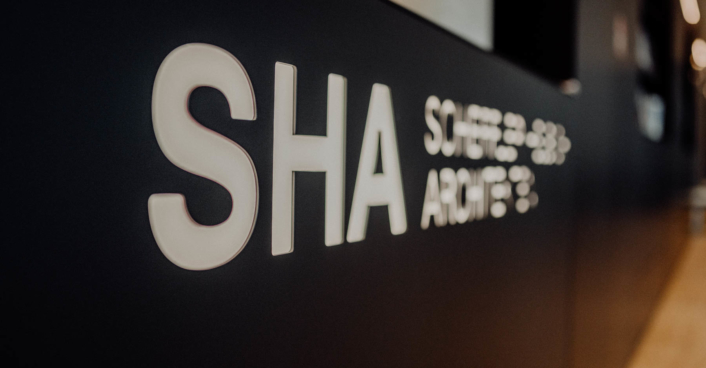
New construction of Heinzelmännchenweg municipal grammar school in Düsseldorf
Realization competition
EXPLANATORY REPORT
Urban development, open space
Located on the eastern edge of the Grafental development area, the project marks the end of the new quarter and also serves as a link and urban mediator between the newly emerging urban density and the surrounding small-scale granularity. The structure forms a sequence of connected volumes, staggered in both position and height, which appropriately structure the large scale of the program, enable the interlocking of interior and exterior areas and structure the open spaces in the form of green courtyards and integrate them into the building. The cubature interweaves the different urban textures and at the same time shields the western quarter from the noise of the railroad line.
As an extension of Hohenzollernallee, a new lively neighborhood square is being created, which is both a public passageway to the railroad crossing and the address of the Heinzelmännchenweg secondary school and the sports hall. The main entrances, the canteen and the café are oriented towards the square and connect the vibrancy of the school with the public space.
In the north of the competition area, as an extension of Metro-Strasse, the access road to the underground parking garage is located below the sports hall, so that car traffic is not necessarily routed through the quarter, but can be intercepted beforehand.
The sports hall to the north of the square is connected to the southern school building by a bridge. This provides internal access to the sports hall on the second floor. In addition, the roof of the sports hall, which serves as an additional outdoor and break area, is directly connected to the school via an external corridor on the bridge on the second floor.
The southern end is formed by the semi-public green and open space with play and sports facilities, which is also accessible to all residents of the neighborhood outside school hours.
Further open spaces are conceivable on the roofs of the southern parts of the building above the first and second floors. Here there are opportunities for open-air classrooms, school and learning gardens and retreat and relaxation areas.
Typology, program, development
In line with the pedagogical concept, the basic building block of the school consists of a cluster of four classrooms organized around a shared multifunctional central zone. Arranged alternately along the main access route running from north to south, these school buildings contribute to the internal address formation and identification of the pupils with their individual areas. The main stairwells and elevators as well as the necessary ancillary rooms and sanitary facilities are located along the north-south spine, which connects the school buildings like an internal road.
A special feature of this typology is the green buffer zone to the west and east of the school buildings. Functionally, it serves as an acoustic barrier and buffer for the multifunctional areas, particularly against the railroad line to the east, but also against the road to the west. Programmatically, this zone is equipped with the necessary second escape routes as external staircases, open spaces as outdoor classrooms or class gardens and cluster-related teacher recreation areas, which can also be used for individual supervision and differentiation.
All classrooms are oriented exclusively to the north or south towards the courtyards between the school buildings, i.e. the sides facing away from the noise.
The sports hall is connected to the school building via a bridge with direct, weather-independent access on the second floor, which is closed outside school hours and enables independent use of the sports hall by external users.
Facts and figures
- Realization competition of the city of Düsseldorf: 2019
- 1st prize for SHA and Gina
A jury of representatives from politics, administration and the professional world reviewed the 15 designs submitted and awarded prizes to two other offices in addition to the planning consortium of SHA and GINA. - The city of Düsseldorf is facing immense challenges in the face of growing pupil numbers, which also offer an opportunity for the school landscape. Numerous schools are being renovated, extended or newly built.

Assessment by the jury
The present urban development concept manages to give the site a strong identity with a significant urban figure and to solve the difficult competition task appropriately. Five interconnected cubes compensate for the difference in scale between the small-scale single-family housing estate to the south and the newly planned multi-family housing district. Both the increasing height development and the staggered, additive arrangement of the buildings achieve a pleasant scale that enhances the location.
The necessary urbanity is provided by a well-proportioned, rectangular square that stretches out in front of the school entrance, the sports hall and the quarter’s high point. The glass bridge between the grammar school and the sports hall is also viewed positively, as it not only connects the two buildings with each other, but also provides urban planning support for the long axis of Hohenzollern Allee. Due to its proximity to the railroad underpass, the northernmost pillar of the school could be at great risk in the later phase of use.
Unfortunately, the open spaces lack the same sensitivity as the urban design. Many areas are presented indifferently and require further elaboration. The uniformly designed outdoor facilities in the east and west are incomprehensible, although the boundary conditions are different. A slightly larger, contiguous schoolyard for secondary level 1 is not designated.
The entrances to the school and sports hall are located on the square due to the partially undercut building structures and provide a good address. As the canteen and kitchen are also located there, a lively atmosphere can be expected in the entrance area.
This liveliness is also pleasantly continued inside the school. The desired school clusters are located in a communicative central zone with differentiated stairs, seating steps and niches. Large pedagogical centers with transparent classroom walls meet the user’s expectations. The classrooms in the east are viewed critically, as they are subject to the same expectations in terms of noise, emission protection and air quality as the west side facing away from the railroad. The efficiency of the proposed façade slat system should be critically scrutinized once again. The trellis in front of it with the external greenery is also viewed critically. The cost-benefit ratio must be explained due to the huge areas involved. Some of the perforated window façades behind them appear banal and their sustainability should be questioned.
The sports hall is characterized by very well-functioning floor plans. Changing rooms and equipment rooms are on the same level. The weather-independent connection between the grandstand and the school building on the upper floor is perceived as very pleasant. The footprint of the sports hall is relativized by the playability of the roof surface as a fifth façade.
The coherent concept of a climate-neutral and sustainable building is welcomed. The authors are the only ones to propose a decentralized usage concept that can also be implemented in times of pandemics in the future.
Due to the relatively small “footprint”, the simple and geometric floor plans and the favorable GFA/NUF ratio, a medium to high economic efficiency can be expected.
The large square is a little too stony and should be given some well-considered tree planting or a small grove of trees as well as a few seating options.
The adjoining connection to the underpass in the direction of Ostpark would have to be integrated even more (e.g. continuation of the pavement).
The area surrounding the school (schoolyard) is poorly designed and appears somewhat too green for school use (functionality). Improvements and details should be made urgently in the next planning phases. The existing trees can be retained as far as possible. Incorporating the roofs into the use of open space is highly conceivable. The extremely high proportion of façade greening up to the 4th floor is questionable. Experience shows that this greening will take a very long time in this large area and up to such a height and may not even be achieved.
Thanks to the simple urban planning concept, the work responds very appropriately to the task and the location. It represents a very valuable contribution to formulating urban planning, sustainable and educational aspects of our time in a future-oriented, innovative architecture.
SHA Scheffler Helbich Architekten GmbH/Architecture
Author: Marc Horstmeier
GINA Barcelona Architects/Architecture, Landscape Architecture
Authors: Jaime Batlle, Diana Carbonell, Davide Lorenzato
Employees: Jennifer Álvarez Delgado, Ignacio Arizu, Laura Carlos, Mariona Mayol, Cristina Zehe
Curious
become?
We would be happy to tell you more.





